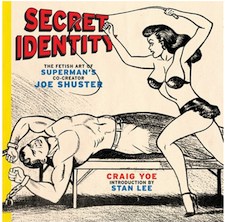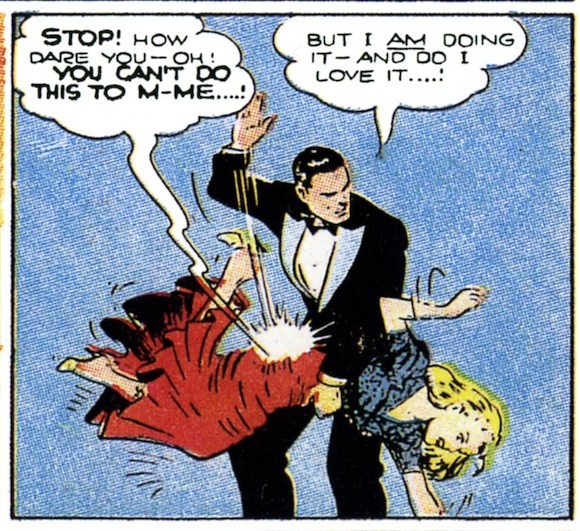This essay first appeared on Comixology.
_________________________
When Craig Yoe first saw the pulp fetish pamphlet Nights of Horror, he instantly gasped, “Oh, my God, Joe Shuster!”
 That expression of shock has a couple of levels to it, I think. First, of course, there’s the simple surprise of discovering unknown work by a seminal cartoonist. Artist Shuster and writer Jerry Siegel created the hugely successful Superman for National Comics in 1938. A decade and much legal wrangling later, though, Siegel and Shuster had lost the rights to their character, and were no longer welcome at the company which had been largely built on their creation. That much of the story is well known — but pretty much nobody was aware that the down-and-out Shuster had illustrated a low-budget porn title like Nights of Horror. In fact, given Shuster’s declining eyesight, some historians weren’t even sure that Shuster could see at all by the mid-1950s when Nights of Horror was produced.
That expression of shock has a couple of levels to it, I think. First, of course, there’s the simple surprise of discovering unknown work by a seminal cartoonist. Artist Shuster and writer Jerry Siegel created the hugely successful Superman for National Comics in 1938. A decade and much legal wrangling later, though, Siegel and Shuster had lost the rights to their character, and were no longer welcome at the company which had been largely built on their creation. That much of the story is well known — but pretty much nobody was aware that the down-and-out Shuster had illustrated a low-budget porn title like Nights of Horror. In fact, given Shuster’s declining eyesight, some historians weren’t even sure that Shuster could see at all by the mid-1950s when Nights of Horror was produced.
The amazement expressed by Yoe and by other comics professionals he quotes in Secret Identity: The Fetish Art of Superman’s Co-Creator Joe Shuster isn’t simply because the work was unknown, however. It’s because of the type of work it is, and the type of artist Shuster is supposed to be. Stan Lee, with his usual talent for dispensing middle-brow wisdom, pithily sums things up in the introduction. “Whereas everything about the stories and artwork of Superman was positive and uplifting, the pages of Nights of Horror…cater to the basest of man’s character and morals.”
So there you have it. Superman is good. Nights of Horror is evil. How, oh how, can we reconcile the two? Lee does it, characteristically, by genuflecting in the direction of tragic irony: Shuster loved the noble and good, but became “so disillusioned and desperate” that he debased his talents and turned to the dark side. Yoe himself isn’t that prudish, but he too sees a contrast. Superman was too perfect, Yoe argues. The discovery that Shuster had a less savory aspect, therefore, makes him, Yoe says, “someone we, with our own flaws can relate too.” Stan the Man looks on with distaste and Yoe looks on with avuncular amusement, but both agree on the central narrative, viz., it was a big step (whether down or sideways) from drawing Superman to drawing fetish art.
But was it? Not everyone thought so. Anti-comics crusader and psychologist Frederic Wertham for example, hated Superman and fetish pulp more or less equally, and for more or less the same reasons. Wertham believed that Superman encouraged “fantasies of sadistic joy in seeing other people punished.” The hyper-masculine, uniformed supermen were a sexualized, godless fantasy of force; a dream of limitless empowerment. Yoe quotes Wertham in the later’s famous screed, Seduction of the Innocent: “We established the basic ingredients of the most numerous and widely read comic books: violence, sadism, and cruelty; the superman philosophy, an offshoot of Nietzsche’s superman, who said, ‘When you go to women, don’t forget the whip.'”
As it happened, Wertham is on record condemning not only comic-book fetishism in general, but Nights of Horror specifically. The psychologist linked the fetish pamphlets to a series of brutal murders and assaults by a gang of young pseudo-Nazis in New York in 1954. As with super-hero comics, Wertham attacked Nights of Horror for its perversion, its sadism, and its general bad influence. Eventually, his testimony helped get Nights of Horror confiscated and destroyed by the state, in a decision upheld 5-4 by the Supreme Court.
Again, Yoe provides all of this information — but he doesn’t quite connect the dots. Perhaps he thinks too highly of Superman, or perhaps he’s simply unwilling or unable to credit rampant Comstockery. Nonetheless, the fact remains: in Wertham’s analysis, if not in his censorious conclusions, the crusading prude was definitely onto something. Whether it’s superheroes or fetish porn, pulp is pulp. And what pulp is made of, in large part is sadistic and masochistic fantasies. It’s not an accident that one of the earliest successful Batman villains, the Monk, was a vampire hypnotist who controlled the wills of his female victims. Nor is it coincidence that the incredibly popular early Wonder Woman stories featured elaborately bound beauties in just about every other panel. And as for Superman…well, how about this:
That’s a panel from the Superman newspaper strip which Siegel and Shuster worked on in the early ‘40s. It took me about a minute to find it by flipping at random through my volume of Superman: Sunday Classics.
So Shuster was into kink, then? Yoe does manage to uncover some evidence that the artist had an eye for chorus girls and the female form. But while that’s interesting, it’s not really the main issue. The point here isn’t that this or that creator had a personal thing for spanking or sadism or masochism. Rather, the point is that as a genre superhero comics simply aren’t that far removed from the kind of pulp fetish porn that Shuster retailed in Nights of Horror. Read through Yoe’s plot synopses of the sixteen plus issues that Shuster illustrated and you’ll get a definite feeling of déjà vu. Damsels in distress, evil hooligans, manly private dicks, and fiendish torture devices — didn’t Shuster illustrate all of this somewhere before? You’ve even got a fair number of men getting shown up just like that milquetoast Clark Kent…though, admittedly, Kent’s humiliation didn’t usually involve a French maid.
The consistency, though, goes beyond the simple details of the plot or the occasional oversexed Jimmy Olsen look alike. Both Nights of Horror and Superman have Shuster’s trademark, rough and ready stiff poses, forthright compositions, and linework-because-we-need-some-linework. It’s not slick, but it does have a kind of charming mass-market anonymity. The dominatrix on the cover of Secret Identity for example; Shuster drew her breast so it looks like a detachable sack draped over her shoulder. It’s as if he just chucked her together piecemeal for the pose, and plans to disassemble her as soon as you turn the page.
And then there are the picture frames on the walls of some of the dens of iniquity drawn in Nights of Horror — picture frames in which Shuster has neglected to place any actual pictures. Yoe suggests that these vacant blank squares evoke the emptiness and cruelty of the bleak pulp world. Really, though, it seems to me likely that Shuster didn’t draw pictures for the frames hanging in the background because…this is porn. Who’s looking at the damn pictures on the wall? Shuster isn’t creating art; he’s creating a delivery system.
This ability to focus on the main bit and ignore the frills was the genius of Superman too, of course. You want a power fantasy? Okay; we’ll give you a power fantasy. Super strength! Invulnerability! Constantly humiliating the girl you desire! What could be better than that, huh? Shuster knew a thing or two about catering to his audience’s desires. That he’d pander is not surprising — though the blatant obviousness of his vision still has the power to startle.

